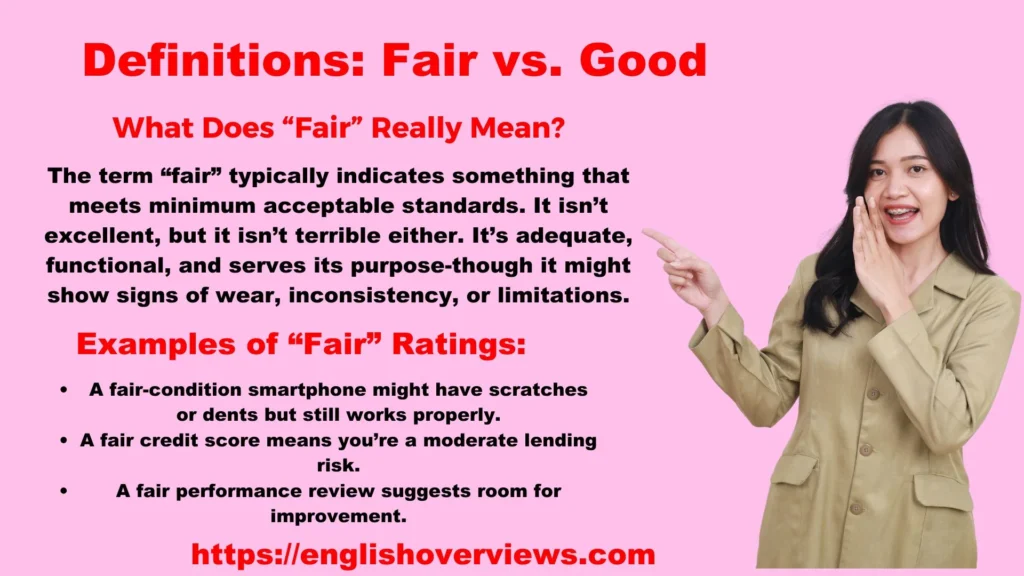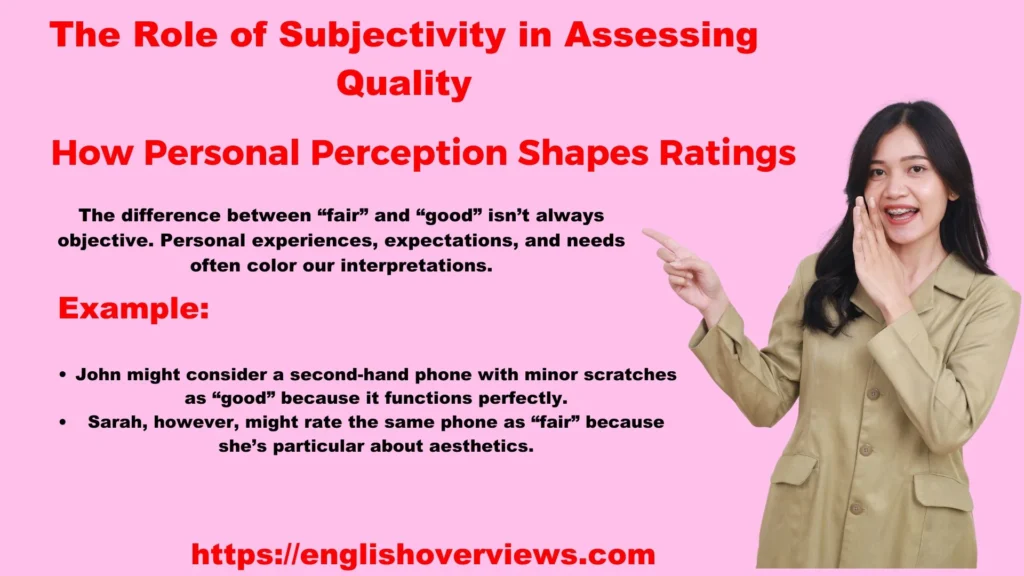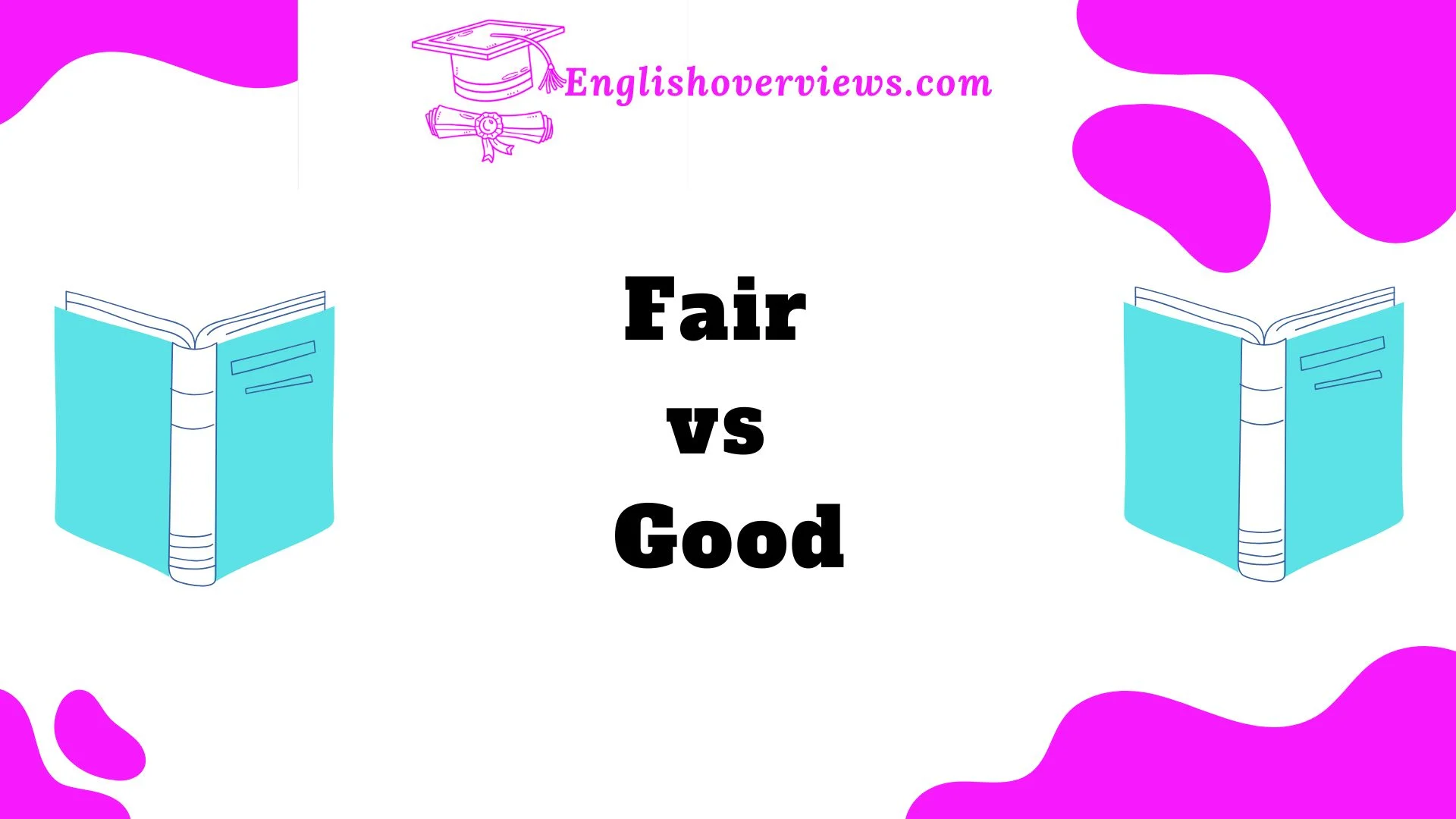When you hear the terms “fair” VS “good,” they might sound similar, but they carry different meanings across various contexts. Whether you’re buying a used phone, evaluating credit scores, or comparing product ratings online, understanding the subtle differences can save you from making poor decisions.
These terms aren’t just labels-they represent expectations, quality standards, and value judgments that vary depending on the industry and the situation.
In this guide, we’ll break down the key differences between “fair” and “good”, explore their applications in real-world scenarios, and provide clear examples, tables, and actionable insights to help you make better choices.
From e-commerce platforms to financial ratings, you’ll gain a deeper understanding of how these labels influence consumer behavior, financial decisions, and overall perceptions.
By the end of this article, you’ll be equipped to:
- Distinguish between “fair” and “good” conditions in different scenarios.
- Evaluate ratings with a critical eye.
- Make smarter purchasing and financial decisions.
- Understand when “fair” might actually mean “good.”
Definitions: Fair vs. Good

What Does “Fair” Really Mean?
The term “fair” typically indicates something that meets minimum acceptable standards. It isn’t excellent, but it isn’t terrible either. It’s adequate, functional, and serves its purpose-though it might show signs of wear, inconsistency, or limitations.
Examples of “Fair” Ratings:
- A fair-condition smartphone might have scratches or dents but still works properly.
- A fair credit score means you’re a moderate lending risk.
- A fair performance review suggests room for improvement.
| Term | Meaning | Example |
| Fair Product Condition | Usable but with noticeable flaws | Used laptop with minor screen damage |
| Fair Credit Score | Moderate financial risk | Score between 580-669 |
| Fair Service | Meets minimum expectations | Average restaurant service |
What Does “Good” Really Mean?
On the other hand, “good” suggests a higher level of quality and satisfaction. A “good” product, service, or score exceeds basic requirements and performs reliably.
Examples of “Good” Ratings:
- A good-condition laptop might look nearly new and function perfectly.
- A good credit score indicates lower financial risk.
- A good customer service experience feels satisfying and smooth.
| Term | Meaning | Example |
| Good Product Condition | Above average, minimal flaws | Used laptop with no visible damage |
| Good Credit Score | Low financial risk | Score between 670-739 |
| Good Service | Smooth and satisfying experience | Prompt restaurant service |
Key Takeaway:
While “fair” meets the minimum standards, “good” indicates reliability and better quality. These distinctions can make a big difference when making decisions.
The Role of Subjectivity in Assessing Quality

How Personal Perception Shapes Ratings
The difference between “fair” and “good” isn’t always objective. Personal experiences, expectations, and needs often color our interpretations.
Example:
- John might consider a second-hand phone with minor scratches as “good” because it functions perfectly.
- Sarah, however, might rate the same phone as “fair” because she’s particular about aesthetics.
Industry Variations in Subjectivity
Different industries define these terms differently:
- In Real Estate: “Fair” could describe an older house that needs repairs, while “good” refers to a well-maintained property.
- In Tech: “Fair” means functional but worn, while “good” suggests minimal wear and reliable performance.
| Industry | Fair Definition | Good Definition |
| Real Estate | Needs repairs but livable | Well-maintained with minor issues |
| Electronics | Functional but worn | Minimal wear, fully functional |
| Clothing | Noticeable defects but wearable | Minor defects, looks fresh |
Psychological Bias in Perception
Our expectations influence how we rate quality. If you’re expecting perfection and receive something average, you might rate it as “fair.” If your expectations are lower, you might find it “good.”
Quick Tip: Always set clear expectations before making a purchase or evaluation.
Contextual Application of Ratings: Fair vs. Good in Everyday Scenarios
E-commerce Platforms:
- On Amazon or eBay, sellers often label products as “fair” or “good.”
- A “fair” laptop might be cheaper, while a “good” laptop might cost more but offer better reliability.
Physical Retail Stores:
- In a thrift store, a jacket labeled “fair” might have visible damage, while one marked “good” might look barely used.
Case Study:
Lisa bought a “fair” condition phone online and a “good” condition phone in-store.
- The online phone worked fine but had unexpected scratches.
- The in-store phone looked pristine and worked perfectly.
Lesson: Visual inspection often reveals more than online descriptions.
Checklist for Evaluating Fair vs. Good Products Online:
- Check seller ratings and reviews.
- Look for detailed product photos.
- Understand the platform’s rating criteria.
Comparison Table: Online vs. In-Store Descriptions
| Factor | Online (Fair) | Online (Good) | In-Store (Fair) | In-Store (Good) |
| Inspection | Limited | Limited | Full | Full |
| Price | Lower | Higher | Lower | Higher |
| Trust Level | Moderate | High | Moderate | High |
Real-World Example: Refurbished Gadgets
- A fair-condition refurbished phone might have a weak battery and scratches.
- A good-condition refurbished phone might look nearly new with a strong battery.
Quick Tip: Always ask for warranty coverage and return policies when buying second-hand.
The difference between “fair” and “good” in real-world purchases often comes down to transparency and context.
Conclusion
Understanding the difference between “fair” and “good” goes beyond just words-it’s about setting the right expectations, making informed choices, and understanding context.
Whether you’re buying a refurbished gadget, assessing a financial rating, or comparing products online, knowing these distinctions helps you avoid disappointment and make smarter decisions.
In essence:
- “Fair” meets the minimum acceptable standard-it’s functional but may have flaws.
- “Good” exceeds the basics, offering better quality and reliability.
When evaluating products, services, or financial ratings, always consider the source, check reviews, and understand the criteria behind these labels. Context is everything.
By applying these insights, you’ll navigate purchases, financial decisions, and quality assessments with confidence.
Frequently Asked Questions (FAQs)
1. What’s the main difference between “fair” and “good”?
“Fair” indicates minimum acceptable standards, often with visible flaws, while “good” suggests above-average quality and reliability.
2. Can “fair” sometimes mean “good”?
Yes, in certain contexts-like vintage items or auctions-“fair” might still represent great value or even equal “good.”
3. Are “fair” and “good” ratings the same across industries?
No. Each industry (e.g., electronics, real estate, finance) has its criteria for labeling something as “fair” or “good.”
4. How can I tell if an online “fair” product is worth buying?
Check seller ratings, product photos, descriptions, and customer reviews. Also, ensure there’s a return policy in place.
5. Do credit scores labeled “fair” and “good” have a big difference?
Yes. A “good” credit score often gives better financial opportunities, such as lower interest rates or higher loan approval chances.
6. Is “fair” always bad?
Not necessarily. A fair product or service can still be functional and valuable, depending on your needs and expectations.
7. Should I always aim for “good” over “fair”?
It depends on your budget, purpose, and the specific item or service. Sometimes, “fair” is perfectly sufficient.
8. Are “fair” and “good” standards consistent worldwide?
No, these labels can vary based on regional markets, cultural perceptions, and industry standards.
9. Can I negotiate prices for “fair” rated products?
Often, yes. Items labeled “fair” usually have more room for negotiation compared to “good” rated ones.
10. How can I avoid disappointment when buying a “fair” product?
Set realistic expectations, research thoroughly, and ask detailed questions about the product’s condition before purchasing.

Alyan Ashraf is the creative mind behind English Overviews, a platform dedicated to helping learners master the English language. Passionate about education and language development, Alyan specializes in simplifying complex English concepts, making learning accessible for students of all levels.











